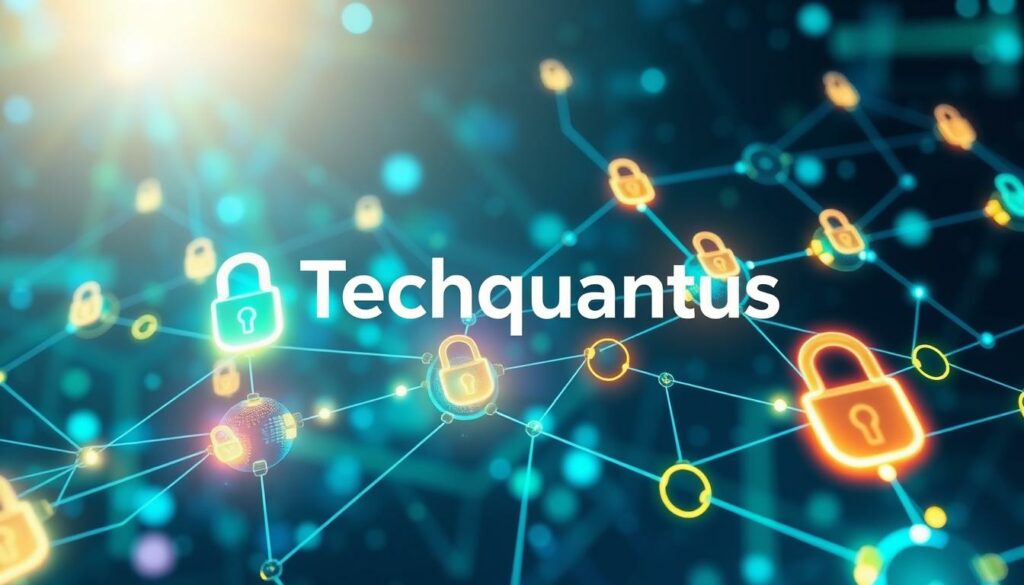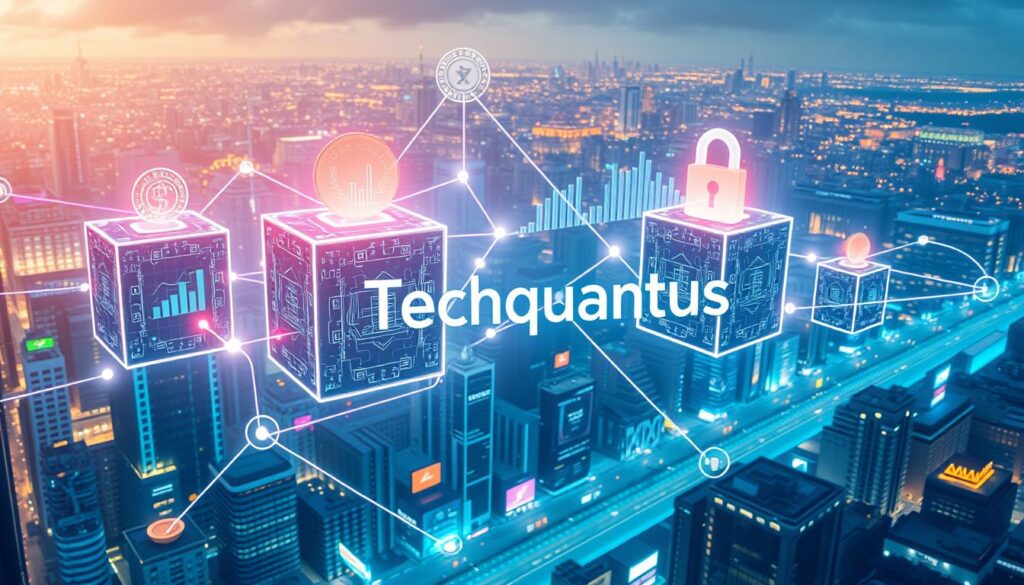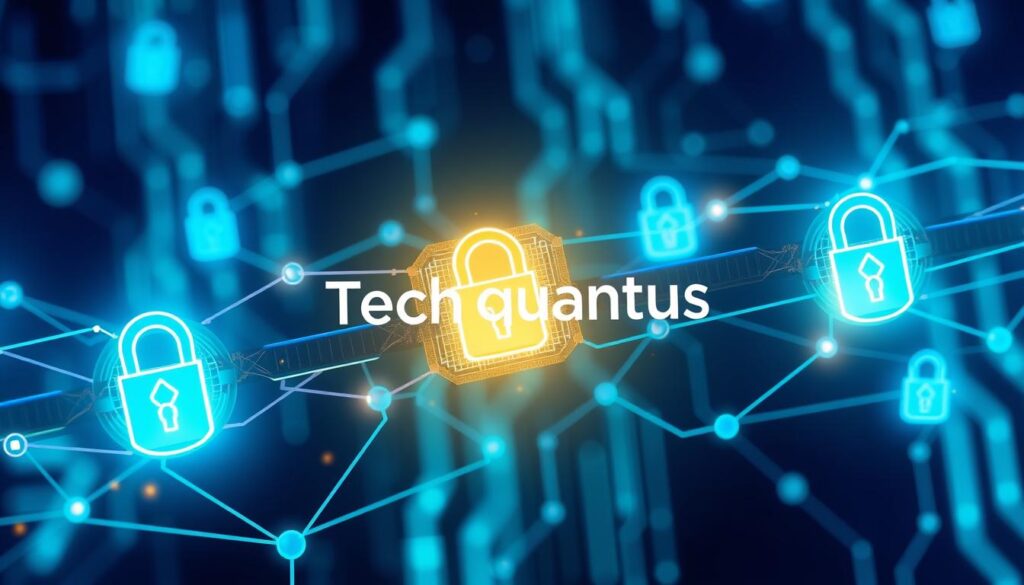Did you know the blockchain industry is expected to hit $4 billion by 2030? This growth isn’t just in cryptocurrency. It’s also in areas like logistics, healthcare, and real estate. New tools like smart contracts and Blockchain as a Service (BaaS) are changing how we do secure transactions.
In today’s digital world, keeping transactions safe is key. Using blockchain can really help. It uses strong cryptography and a decentralized ledger to protect transactions, making it a big deal in finance and more.
Starting your blockchain journey means exploring many uses. It can help fight fraud and work with AI for better security. The Metaverse and Web3 are also making blockchain a big player in digital security.

By using blockchain, you join the latest trends and build trust with your customers. For more on blockchain’s impact, check out how blockchain is changing things. It’s an exciting time to be part of this change.
Key Takeaways
- The blockchain market is set to grow significantly, reaching $4 billion by the end of the decade.
- Blockchain technology is applicable in various industries, beyond just cryptocurrency.
- Smart contracts, such as those on the Ethereum platform, offer new transaction methodologies.
- Businesses are exploring Blockchain as a Service (BaaS) to simplify access to blockchain solutions.
- AI can enhance blockchain security by identifying risks and mitigating vulnerabilities.
- Fraud protection strategies are evolving with blockchain technology for improved security.
- The rise of the Metaverse is likely to accelerate blockchain adoption for secure, decentralized transactions.
Understanding Blockchain Technology
Blockchain technology is a big leap forward in digital transactions and data storage. It uses a distributed ledger to keep many copies of transaction records. Each block in the chain has important data and a special code that links it to the next block.
This setup makes it hard to change information without everyone agreeing. This boosts security and trust.
Blockchain is big in the crypto market, with currencies like Bitcoin and Ether. The U.S. has seen the launch of Bitcoin and Ether ETFs. This shows more people are interested in blockchain for finance.
There’s also talk about XRP and Solana ETFs coming soon. This shows how fast digital currencies are changing.
But blockchain isn’t just for finance. Schools can use it to fight fake credentials. They can store certificates safely on a blockchain. This makes academic achievements more credible and secure.
Smart contracts in blockchain can also help with school tasks. They can manage courses and track student progress. This helps teachers and school staff a lot.
In short, knowing about blockchain is key to seeing how it’s changing things in finance and education.
| Blockchain Features | Benefits |
|---|---|
| Distributed Ledger | Increased security through redundancy and consensus |
| Cryptographic Hashing | Data integrity and tamper resistance |
| Smart Contracts | Automation of tasks, reducing administrative burden |
| Immutability | Ensured authenticity of digital records |
The Importance of Secure Transactions
In today’s world, secure transactions are more important than ever. Fraud and data breaches are on the rise. This makes keeping financial security a top priority for everyone.
Companies spend a lot to make sure transaction integrity is maintained. This builds trust and stability in the market.
The growth of blockchains is a big reason for this need. Layer-1 blockchains create a secure, independent way to do transactions. They make transactions transparent and safe from fraud.
Not using secure transaction methods can hurt businesses a lot. It can lead to lost sales and a bad reputation. Investing in financial security is not just smart; it’s necessary to stay competitive.
Looking at international payments shows how important secure transactions are. Banks are working together more, using digital currencies like XRP. This shows a trend towards better security and new technologies for safer transactions.
| Key Factors | Impact on Financial Security | Example Technologies |
|---|---|---|
| Fraud Awareness | Heightened importance of securing transactions | Blockchain, Cryptography |
| Data Breaches | Investment in security systems is crucial | Multi-signature wallets |
| Transaction Integrity | Fostering trust between businesses and consumers | Smart contracts |
How Blockchain Ensures Security
Blockchain technology uses two main parts to boost Blockchain security: decentralized ledger tech and cryptography. These elements work together to make a safe space for transactions. It’s hard for unauthorized groups to change or get to sensitive data.
Decentralized Ledger Technology
Decentralized ledger tech is great because it doesn’t rely on one person or group to keep records. Everyone in the network has a copy of the ledger. This means no one can change the data without everyone knowing.
This setup cuts down on fraud and data breaches. It also makes sure everyone can see and check the data. This openness helps build trust and strengthens Blockchain security.
Cryptographic Security Measures
Cryptography is another key part of blockchain’s security. It encrypts each transaction, making it hard to change. If someone tries to alter a transaction, it’s caught right away.
These cryptography methods keep data safe and true. To learn more about blockchain’s security benefits, check out this resource.
| Feature | Description | Benefit |
|---|---|---|
| Decentralization | Elimination of a single point of control. | Reduces fraud risk. |
| Transparency | All participants can view the transaction history. | Fosters trust among users. |
| Cryptographic Hashing | Each transaction is encrypted with unique hash values. | Protects against data alteration. |
| Consensus Mechanisms | Agreements among participants validate transactions. | Prevents unauthorized transactions. |
Applications of Blockchain in Financial Transactions
Blockchain technology goes beyond just cryptocurrencies. It changes how we do financial transactions in many areas. For example, it makes cross-border payments faster and cheaper. This is because blockchain is decentralized, unlike traditional banking systems.
Real estate also gets a big boost from blockchain. It creates a clear and safe record of who owns what. This reduces fraud and makes buying and selling properties quicker and more transparent.
Decentralized finance (DeFi) is another area where blockchain shines. It allows for direct transactions without banks. This makes financial services more accessible and can cut down on costs.
As blockchain becomes more common in finance, it brings more trust and safety. The industry is changing with new tools like Blockchain as a Service (BaaS) and artificial intelligence. For more on blockchain’s future, check out this article on trends shaping the next decade.

| Application | Description | Benefits |
|---|---|---|
| Cross-Border Payments | Permits direct transactions across borders without intermediaries. | Speed, reduced fees, and increased efficiency. |
| Real Estate Transactions | Maintains a transparent and reliable record of property ownership. | Prevents fraud and expedites ownership transfer. |
| Decentralized Finance (DeFi) | Enables peer-to-peer lending, borrowing, and trading. | Increased accessibility and lower transaction costs. |
Blockchain Development and Its Impact
Blockchain technology is changing many sectors, especially in finance. It makes things more transparent, which builds trust with customers. This leads to stronger relationships between businesses and their customers.
When companies use blockchain, they focus on security and efficiency. This changes how trust is built in transactions.
Building Customer Trust
Blockchain is helping businesses build customer trust. It uses a clear ledger system. This lets customers check transactions themselves, reducing fraud risk.
Customers are more aware of data privacy issues. Blockchain’s transparency helps companies keep data safe. This boosts consumer confidence in their services.
Integration with Existing Financial Systems
Adding blockchain to financial systems is both a chance and a challenge. Businesses face issues with compatibility. But, blockchain can make processes smoother, cut costs, and improve systems.
Companies can adapt by training staff and forming partnerships. This helps them use blockchain with their old systems.
Here’s a table that compares traditional financial systems and blockchain technologies:
| Aspect | Traditional Financial Systems | Blockchain Technology |
|---|---|---|
| Transparency | Limited, often opaque | High, fully auditable |
| Security | Prone to fraud | Cryptographically secure |
| Customer Trust | Varies based on institution | Enhanced through accountability |
| Cost of Transactions | Often includes high fees | Potential for zero fees |
| Speed of Transactions | Can be slow and cumbersome | Fast and efficient |
By focusing on building customer trust and solving financial integration challenges, businesses can use blockchain. This can change how customers experience services and improve efficiency.
Decentralized Finance: A New Era
The world of finance is changing fast with decentralized finance (DeFi). This new way of finance gives you more control over your money. It also cuts out the middlemen, making financial services more accessible to everyone.
McKinsey & Company says the market for tokenized real-world assets could hit $2 trillion by 2030. Phlomis Finance is helping make this happen. They make financial tools available to more people through tokenization. They also focus on investing that’s good for the planet and transparent.
Thanks to blockchain, we can now get financial data and impact metrics in real-time. This helps us make better choices. Chromia’s blockchain technology makes things even better by being faster and storing complex documents well.
Big names like Bank of America and BlackRock are also looking into tokenizing real-world assets. Their interest shows how blockchain is changing finance. Phlomis Finance is set to launch its first tokenized products in Q4 2024. This shows how DeFi is making finance more inclusive. Learn more about Phlomis Finance’s role in this change with innovative solutions.

Using Cryptocurrency for Secure Transactions
Cryptocurrency is becoming more popular for secure transactions in the blockchain world. It offers many benefits that solve old banking problems. But, it also has risks that users need to think about.
Benefits of Cryptocurrency
One big benefit of cryptocurrency is lower fees. Banks often charge a lot for moving money across borders. Cryptocurrencies make this cheaper and faster.
Staking can also earn you extra money. By holding coins, you help the blockchain network and earn income. This makes transactions more efficient.
- Passive income generation through staking
- Reduced transaction costs
- Faster processing times than traditional banking
- Potential for higher returns compared to savings accounts
Staking, especially with coins like Ariva $ARV, helps the network and earns you money. DappRadar helps users understand staking through analytics. Holding coins helps stabilize the market and lets users vote on important decisions.
Risks and Considerations
Investing in cryptocurrency has risks and considerations. The market can be very volatile, leading to price swings and losses. Smart contracts can also be a security risk.
It’s important to use strong security measures. Multi-factor authentication (MFA) and hardware wallets can protect your investments. This helps keep your money safe.
| Risk Factor | Mitigation Strategy |
|---|---|
| Market Volatility | Diversification of holdings |
| Smart Contract Vulnerabilities | Conduct regular audits |
| Security Threats | Use of MFA and hardware wallets |
| Regulatory Challenges | Stay updated on legal developments |
As cryptocurrency evolves, it’s key to know the benefits and risks of secure transactions. By understanding both sides, you can make smart financial choices.
How to Start with Blockchain for Transactions
To start using blockchain for secure transactions, you need to know the different methods. Both individuals and businesses can benefit from using blockchain. It makes transactions safer and more efficient.
Begin by learning about platforms like Ethereum. They use smart contracts to make processes smoother. This knowledge helps you make better choices in the blockchain world.
Using the right blockchain tools is key to success. Look for platforms that offer Blockchain as a Service (BaaS). These platforms make it easy to manage transactions without a big tech investment. This makes switching to blockchain easier and improves security.
As you start, watch for new trends like AI and better fraud protection. Today, over 100 layer-1 blockchains are available. Find the tools that fit your needs to use blockchain for secure transactions. For more on tech and security, check out this resource on quantum computing.
FAQ
What is Blockchain technology?
Blockchain is a digital ledger that keeps records on many computers. It makes sure these records can’t be changed later. This keeps things transparent and safe, which is why it’s used for things like digital money and secure deals.
How does Blockchain ensure secure transactions?
Blockchain keeps deals safe with its digital ledger and strong encryption. It’s hard for anyone to change records without everyone agreeing. This keeps the data safe and sound.
What are the main applications of Blockchain in finance?
In finance, Blockchain is used for many things. It helps with money sent across borders, buying and selling real estate, and in DeFi. It makes deals faster, cheaper, and more open, changing how we do finance.
What is Decentralized Finance (DeFi)?
DeFi is a new way of doing finance on Blockchain. It lets people control their money themselves, without middlemen. It makes finance more open and fair for everyone.
How can cryptocurrency support secure transactions?
Cryptocurrency makes deals on Blockchain faster and cheaper than banks. But, it’s important to watch out for risks like price swings and rules changes.
What challenges exist in implementing Blockchain technology in financial systems?
Using Blockchain in finance can be tough. It’s hard to fit it into old systems and follow rules. Companies need to plan carefully to make the switch smoothly.
How do I start using Blockchain for transactions?
To use Blockchain for deals, learn about different ways to do transactions. Pick the right platforms and tools. This will help you get started with this new tech.
Source Links
1 . https://coingape.com/blog/the-future-of-blockchain-what-trends-are-shaping-the-next-decade/
2 . https://www.financemagnates.com/cryptocurrency/coindesk-brings-ccdata-and-cryptocompare-on-board-for-data-services/
3 . https://www.the-blockchain.com/2024/10/16/xrp-etfs-cme-director-describes-first-initiative-in-that-direction/
- Discover AI Innovations Revolutionizing Computing
- Boost Your Internet Speed: Advanced Techniques
- I Figured Out Why Your Internet is Slow and How to Fix It Fast
- How to Optimize Your Internet Experience
- How I Stay Ahead in the Digital Age: A Step-by-Step Guide
Related posts:
 Data Privacy Regulations: What IT Professionals Need to Know in 2024
Data Privacy Regulations: What IT Professionals Need to Know in 2024
 The Global Race for Quantum Computing Dominance: Who’s Leading?
The Global Race for Quantum Computing Dominance: Who’s Leading?
 How to Create High-Quality Synthetic Media Using AI
How to Create High-Quality Synthetic Media Using AI
 How to Integrate 5G and IoT for Smart Cities Development
How to Integrate 5G and IoT for Smart Cities Development
 How to Set Up a Virtual Firewall for Your Cloud Infrastructur
How to Set Up a Virtual Firewall for Your Cloud Infrastructur
 How AI and IoT are Driving Innovation in IT
How AI and IoT are Driving Innovation in IT
